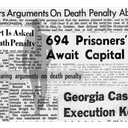
Virginia made history in 2021 when it became the first Southern state to abolish the death penalty. Closing the Slaughterhouse: The Inside Story of Death Penalty Abolition in Virginia tells the story of the commonwealth’s journey from leading executioner to groundbreaking abolitionist state. Written by journalist, author, and anti-death penalty advocate Dale Brumfield, the book explores Virginia’s history surrounding capital punishment, starting with the first execution in 1608 through its abolition on July 1, 2021.
Characteristic of states whose criminal laws grew out of a legacy of slavery, lynching, and Jim Crow segregation, the capital punishment system in Virginia was deeply rooted in racism and shrouded by a veil of secrecy. Leading the nation with 1,390 executions throughout its history, Virginia also executed more enslaved individuals and women than any other state. The state continued heavily using the death penalty in the modern era, beginning in 1976, even adopting draconian procedural rules to short-circuit judicial review and facilitate swifter executions. In contrast to the nationwide average of 16% of death sentences resulting in execution, Virginia executed 73% of those receiving death sentences from 1976 to 2017. The commonwealth’s curtailment of the death row appeals process in 1999 reduced the timeframe for appeals to less than 5 years, half the national average at the time.
In 1991, a Virginia Tech Center for Survey Research poll reported that 80 percent of Virginians said they supported the death penalty; however, support fell to 60% when participants had life without parole as an alternative option. “When combined with some form of restitution to murder victims’ families,” support was less than 57%. A group of 13 anti-death penalty organizers identified the importance of this poll, and Henry Heller, the first volunteer director of what came to be known as Virginians for Alternatives to the Death Penalty (VADP), said “let’s do something with it.”
Brumfield catalogues VADP’s 20-year effort to abolish the death penalty. The organization, he writes, offered pen-pal programs, sent out newsletters, and provided support services for those on death row and their families through the Death Row Support Project. Successful VADP lobbying efforts defeated the “Triggerman” bill, Brumfield writes, preventing the expansion of capital punishment to anyone who assisted in capital murder, intentionally or not.
Despite their “significant 2010 triggerman victory” and amidst a number of expansion bills in the General Assembly, VADP lost a signification amount of funding in 2010 from foundations that were “instead investing in states where abolition looked more promising.”
In 2015, the organization adopted a 5‑year plan for abolition, a core piece of this plan included garnering support from conservatives. Steve Northrup, the volunteer executive director, recalled including “Reasons that would appeal to conservatives, such as you don’t trust big government, why would you trust the government to get [death] right?”
Joining VADP as Executive Director in 2015, Michael Stone likened organizing the abolition movement in 2021 to being the “conductor of a symphony. The key is understanding how the symphony works together and then bringing in the key pieces, the prosecutors the victim’s family members, the conservatives, the media, grassroots activists, and our allies at the appropriate time. Just orchestrating that was certainly very satisfying.”
In the wake of George Floyd’s death and the rise of the Black Lives Matter movement, VADP issued a statement authored by Stone and board chair Kristina Leslie stating that “Sadly, once again, with the horrific murder of George Floyd, we are reminded of these outrages…. The death penalty is a poster child for everything wrong with our criminal justice system — blatant racial disparities, police and prosecutor misconduct, and the propensity for convicting innocent men and women.”
The book describes Governor Ralph Northam signing death penalty abolition into law on March 24, 2021, “inside a tent in the shadow of the state’s execution chamber at Greensville Correctional Center.” Governor Northam explained, “’Ending the death penalty comes down to one fundamental question: Is it fair?… But we all know that the death penalty cannot meet those criteria. That is why it is time in the Commonwealth of Virginia to end the death penalty.’”
Dale Brumfield, Closing the Slaughterhouse: The Inside Story of Death Penalty Abolition in Virginia, Abolition Press, 2022; Dale Brumfield, How Virginia’s Death Penalty Finally Ended, Washington Monthly, May 7, 2021; James A. Bacon, The Mercy Seat, Bacon’s Rebellion, May 29, 2022.



